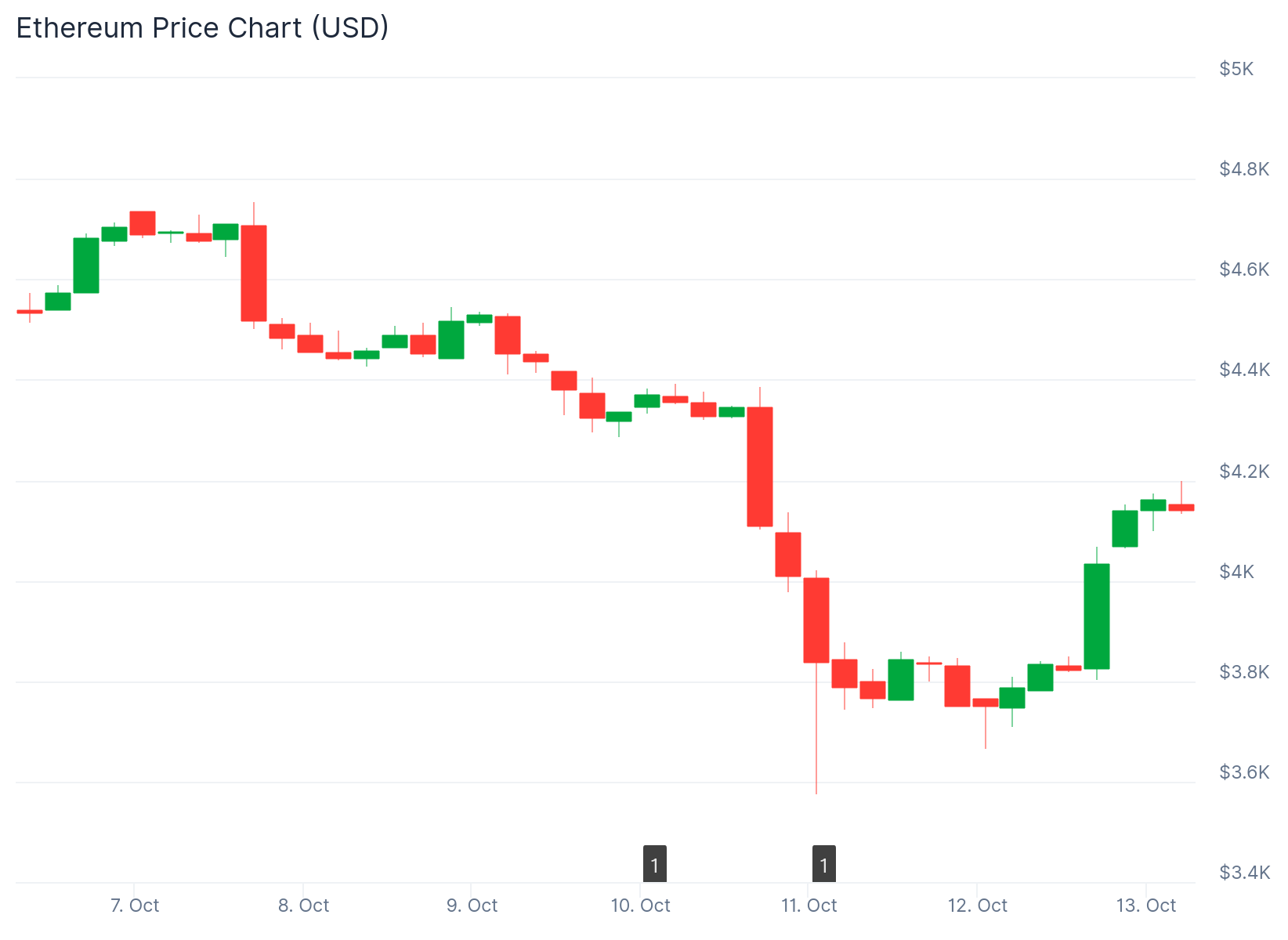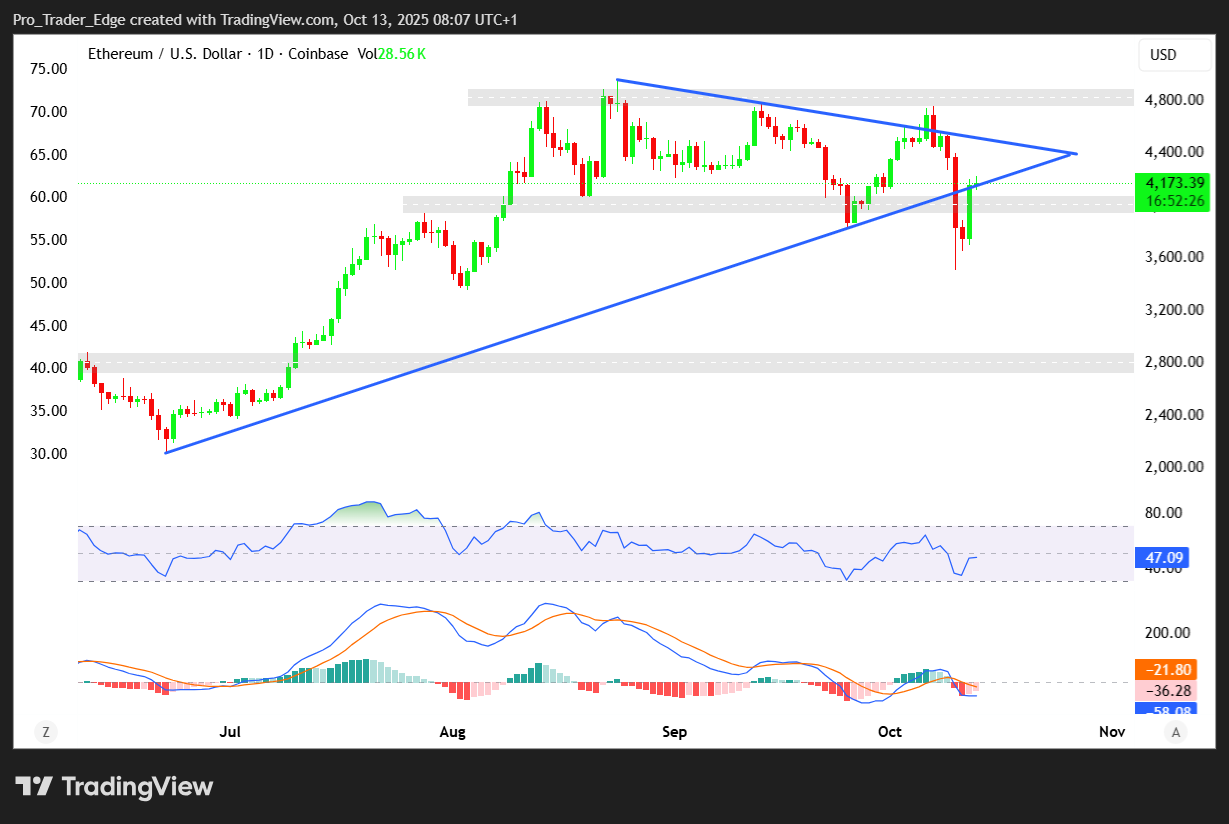TLDR
- ETH rebounded to $4,100 after a 20.7% flash crash liquidated $3.82 billion in leveraged long positions
- Trump’s announcement of 100% China tariffs effective November 1 sparked market-wide selloffs
- Futures markets recovered within two hours, with monthly contracts regaining neutral 5% premium levels
- Ethereum outperformed competing altcoins, dropping only 5% in 48 hours versus 10% for rivals
- Options markets remained balanced without unusual bearish demand, showing healthy derivative structure
Ethereum price climbed back above $4,100 on Sunday following a severe weekend crash. The recovery marks a turnaround from Friday’s drop to $3,750 support.

The flash crash wiped out $3.82 billion in leveraged long positions. This liquidation event created lasting effects on ETH derivative markets.
President Donald Trump triggered the selloff by confirming 100% tariffs on Chinese imports. These tariffs take effect November 1, 2025.
The tariff announcement created risk-off conditions across all asset markets. ETH fell through the 50-day moving average positioned near $4,400.
Multiple support zones failed during the decline. The $4,350 level broke first, then the $3,800 consolidation zone collapsed.
Futures Markets Return to Normal
Perpetual futures funding rates dropped to negative 14%. Short traders paid fees to keep bearish positions open.
This unusual situation typically indicates fears about exchange or market maker solvency. Traders exercise more caution until confidence returns.
Monthly futures contracts absorbed the volatility shock in under two hours. These contracts quickly restored the 5% premium that signals neutral market conditions.
The weakness in perpetual contracts reflects product design flaws rather than bearish sentiment. This distortion may persist for weeks as market makers rebuild confidence.
Binance allocated $283 million for trader compensation. Additional cases remain under review by the exchange.
Wrapped tokens and synthetic stablecoins suffered the worst price dislocations. Trader margins fell up to 50% within minutes due to these asset drops.
ETH Demonstrates Relative Strength
Options trading on Deribit showed no stress signals. Weekend volumes stayed normal with balanced activity.
Put option activity ran slightly below call option levels. This balance indicates healthy market conditions.

Ethereum significantly outperformed other major altcoins during the crash. SUI plunged 84%, Avalanche dropped 70%, and Cardano fell 66%.
ETH declined only 5% over 48 hours. Competing altcoins remain approximately 10% below pre-crash prices.
This performance gap stems from institutional investment products. Ethereum spot ETFs hold $23.5 billion in assets.
The options market contains $15.5 billion in open interest. These institutional flows provide stability during volatile periods.
BNB, XRP, SOL, TRX, and DOGE posted steep losses. The narrow performance dispersion points to macro factors driving the selloff.
Cross-asset correlations increased during the decline. Stock futures fell as tariff news spread through markets.
The dollar gained strength while Treasury yields moved inconsistently. These patterns reflect typical flight-to-safety behavior.
Key Price Levels and Market Structure
Stablecoin markets maintained functionality throughout the crisis. Major pairs held near parity after initial volatility.
Exchange inflows increased during the drawdown period. Large transfers occurred but appeared spread across many sellers rather than coordinated.
The $3,800 to $3,500 range represents the critical decision zone. Holding this area could enable retests of $4,200 to $4,400 resistance.
A breakdown below $3,500 would open a path toward $3,200. That level aligns with previous accumulation zones from late summer.
The 200-day moving average sits near $3,100. This longer-term indicator defines primary trend direction for many traders.
Ethereum currently trades above $4,000 as derivative markets continue normalizing. Futures premiums remain stable and options activity shows balanced positioning.


